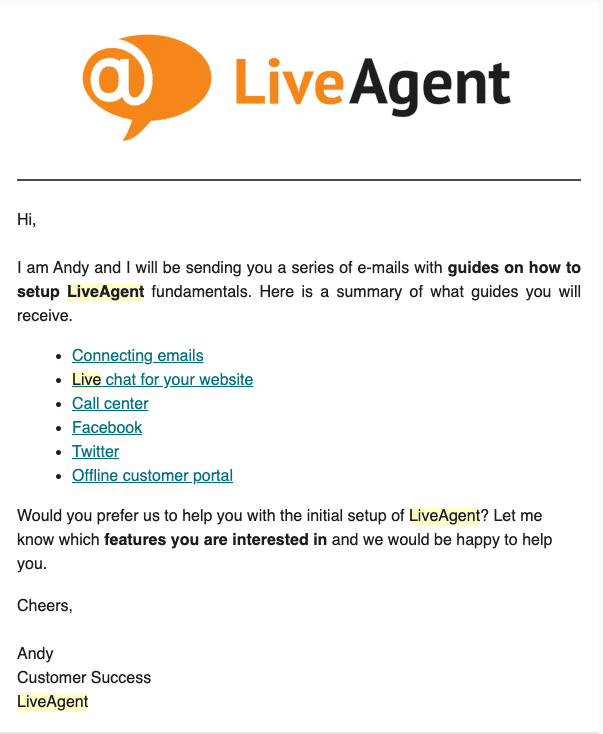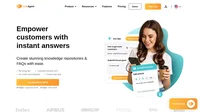- Email Templates
- Newsletter email templates
Newsletter email templates
Discover the significance of newsletter email templates in digital marketing. Learn how they boost engagement, explore templates for various industries, and get tips for effective subject lines. Enhance your strategy with valuable, consent-based communication.

Many so-called experts have been announcing the end of email marketing for the past few years. However, this channel, an integral part of the marketing matrix, is still going strong.
Email newsletters, which are a specific form of email messaging, are not dying out any time soon. On the contrary, they are gaining more and more importance in the digital strategies of most companies. Because of this, a newsletter is still a necessary communication tool, as long as its use is reasonable and has a purpose.
What is a newsletter email?
A newsletter is a digital publication that is distributed at regular intervals (daily, weekly, monthly, bimonthly, or quarterly) via email. Newsletters are usually made up of different articles about a brand, company, or the sector in which it operates, accompanied by an offer or CTA (call to action).
Typically, people who receive this type of communication are subscribers who have previously shown interest in the business and its products or services and have agreed to receive this newsletter. This is vital, as you should only send email updates to users who have consented to receive them.

Moreover, businesses must consider specific legal regulations in different areas of the world, such as GDPR in Europe, before sending out email communications. These regulations apply to any organization operating within a certain region, as well as any organizations outside of that region that offers goods or services to customers or businesses in that region.
Remember to always include an unsubscribe button or link inside your newsletter, preferably at the bottom of your email template. The recipients of your email newsletters should always have the possibility to opt-out from receiving your emails.
91% of consumers check their email on their smartphones at least once a day (source), so don’t forget to create responsive, mobile-friendly newsletters!
Why should you implement a newsletter email in your marketing strategy?
A registered user that has agreed to receive email communication from your company is of great value. If you have a list of active subscribers, there are tons of reasons why sending out newsletters is beneficial:
- An email has a much longer life cycle than content posted on social media.
- 91% of consumers check their email at least once a day on their smartphones (source), so don’t forget to create responsive, mobile-friendly newsletters!
- 89% of marketers consider email as the primary channel for lead generation (source).
- 80% of consumers prefer email as a marketing communication channel (source).
- Email marketing has a much higher ROI (4,300%) than other digital communication channels (source).
- It’s quite a cheap marketing channel compared to PPC and doesn’t require any upfront financial investment.
- The audience that receives email newsletters from you agreed to receive your content, so they are already interested in hearing from you.
- It delivers results quicker than SEO.
- It enables you to bring more traffic to your website.
There are many advantages to sending newsletters. However, you must be careful when executing this communication strategy. Always think of the user first, and ensure that you are delivering value with whatever you’re sending their way.
3 newsletter email template ideas
Now let’s take a look at some useful newsletter email templates.
Newsletter templates to send out offers
The year is full of special occasions and seasons for dedicated promotions, and your clients are probably waiting to know what you have prepared for them. Winter or summer sales and commercial dates like Black Friday, Cyber Monday, Christmas, Eid al-Fitr, Eid al-Adha, and Epiphany (in Spain) are just a few examples of notable days that you should take advantage of to increase your conversions.
Take a look at some of our newsletter email templates that you can use in your next campaign. Don’t forget to add enticing visuals of the item(s) that you are promoting into your email templates.
Hello [subscriber’s name],
It’s that special time of the year again – [Name of a season or holiday] is near, and we wanted to let you know all about the special offers that we’ve prepared for you:
Offer no. 1 with a description
Offer no. 2 with a description
Offer no. 3 with a description
…
Take advantage of these [discounts/offers/promotions] by clicking the button below.
[CTA]
Happy shopping and have a nice [Name of the season/holiday]!
Best wishes,
[your name & company’s name]
Newsletter email template for different industries
Do you need an email newsletter template that’s specifically related to your industry?
Use the template below to message your customers, regardless of your industry — tourism, the automotive industry, services, catering, or the real estate sector.
Hi [subscriber’s name],
You are an active subscriber of our mailing list [Name of a newsletter – if applicable], that’s why we think you’ll be interested in the latest news and information from [company].
We’re sending you a list of [articles posted by your company/industry articles/industry reports/ebooks] that we’ve curated especially for those who subscribe to our newsletter.
[List of the resources with short descriptions with CTAs like “Read more”/ “Read the article”/” Download the ebook”/” Check the report”, etc.].
[Don’t forget to use visuals!]
Happy reading!
Best,
[your name & company’s name]
Email newsletter template for sending informative messages
The template below will work well if you need to send a clear and direct message to your newsletter subscribers.
So, when can you use this email newsletter template? Whenever you want to inform the recipients about an upcoming event, let them know that you are about to launch a new product/service, or notify them about a new feature. And again, as mentioned below, don’t forget to use visuals!
Hi [subscriber’s name],
Here’s a dose of [weekly/bi-weekly/monthly/quarterly] news from [company].
We’re going to launch/We’ve just launched a new [product/feature/service] this [week/month/quarter] and we wanted you, our valued newsletter subscriber, to be one of the first to hear this exciting announcement.
[A description of an item(s) that the message refers to.]
If you are interested in purchasing any of these [product/feature/service], just click the button below. We’ve prepared a special discount that is only available for the recipients of this message.
or:
Check your inbox frequently. Our subscribers are always the first to know about our new releases, and we always prepare special offers and discounts for you.
[CTA]
Best,
[your name & company’s name]
14 newsletter email subject line examples
- [company]: [Name of a subscriber], try out our new treat
- Don’t forget to claim your [amount of discount]% off!
- A dose of the latest news from [company] especially for you, [Name]
- [Name of a subscriber], check out these hand-picked looks from [company]
- [Name of a subscriber], It’s your last chance to save big this [Name of a holiday/season]
- [Company]: [Today/tonight/this week/this month] only. Save [amount of a discount] on your next order
- Get your free [product/or service] by simply reading this email
- Ever wonder how [a certain area of expertise] works at [a Fortune 500 company/any other list of successful/renowned companies]?
- Are you a [name of a certain profession] who wants to [desired outcome]
- What every [name of a certain profession] needs to know about [specific area of knowledge]
- For a [name of an activity] enthusiast: 8 [name of a industry] Tips for [certain activity]
- For a digital marketer: How [name of a company] generates [impressive business results]
- For [name of a certain profession] who hate to [pain point]
- Confidential message to [a product] owners
Frequently Asked Questions
How often should a newsletter be sent?
Newsletters should be sent out regularly so that you’re not forgotten by your subscribers. However, sending out newsletters too frequently can make your readers feel like they’re being spammed and bothered. Sending out newsletters monthly or bi-weekly is very common, however, anything between two weeks and two months is reasonable. Be consistent, though – don’t send two newsletters in three weeks and then go radio silent for two months.
How long should my newsletter be?
Content should be short, skimmable, and presented in small chunks. Generally, consumers spend only a few seconds skimming over emails, picking up on general keywords and topics. If they spot something relevant, they will slow down and read your message more carefully. Start by writing your email, and then continue editing down until you’ve presented the key information in the shortest and sweetest way possible.
How can I measure the success of my newsletter?
The most useful metrics for measuring the impact of a newsletter are the percentages of delivery rates, open rates, click-through rates, and bounce rates. All reliable marketing agencies or email marketing tools will provide these statistics. The delivery rate is the ratio of emails that didn’t bounce to the number of emails sent.The open rate is the ratio of subscribers who opened your newsletter to the number of emails delivered.The click-through rate is the ratio of people who clicked links inside the email to the number of emails delivered.The bounce rate is the ratio of email addresses in your newsletter list that did not receive your message, because their mail servers or clients returned them, to the total number of email addresses in your list. Typically, you want to aim for: A 95% or higher delivery rateA 30% open rateMore than 10% of click-through ratesA less than 2% bounce rate However, these rates and benchmarks may vary from industry to industry. The most important elements that influence these results are a campaign’s data quality and the value of content.
All-in-one knowledge base software
Create stunning knowledge bases & FAQs with LiveAgent! Empower customers with instant answers. Free 30-day trial, no credit card required.
You will be
in Good Hands!
Join our community of happy clients and provide excellent customer support with LiveAgent.

Our website uses cookies. By continuing we assume your permission to deploy cookies as detailed in our privacy and cookies policy.

 Български
Български  Čeština
Čeština  Dansk
Dansk  Deutsch
Deutsch  Eesti
Eesti  Español
Español  Français
Français  Ελληνικα
Ελληνικα  Hrvatski
Hrvatski  Italiano
Italiano  Latviešu
Latviešu  Lietuviškai
Lietuviškai  Magyar
Magyar  Nederlands
Nederlands  Norsk bokmål
Norsk bokmål  Polski
Polski  Română
Română  Русский
Русский  Slovenčina
Slovenčina  Slovenščina
Slovenščina  简体中文
简体中文  Tagalog
Tagalog  Tiếng Việt
Tiếng Việt  العربية
العربية  Português
Português 